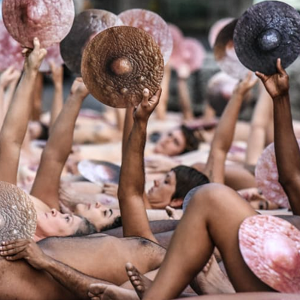[CLASS]ICAL NUDITY
Exposed bodies are never fully uncovered. Stripping away clothing doesn't strip away layers of class and cultural signifiers.
In this section, we explore ways some unclothed bodies are strategically re-covered in class narratives,
often by overlaying Classical traditions of art, sculpture and mythology.
When an unknown woman spontaneously stripped naked and walked in front of a militant police line in Portland, USA, in 2020, a chance social media reference to ‘Naked Athena” soon became a mainstream press moniker. Jen, as she later identified, had joined others on the fiftieth night of protest against the 2020 murder of George Floyd. “I just wanted them to see what they're shooting at,” she later commented.
“I think it's interesting that people are wanting to pull historical figures into this thing, and also mythological figures.”
Known for supporting male heroes, the Greek goddess Athena is often depicted sporting a helmet. The connections with Jen, a light-skinned woman who was wearing nothing but a stocking over her head, were something of a stretch. The moniker did, however, consciously reframe a powerful, live nude pose as something statuesque: an art form to be admired as much as a news item to be reported. In naming, protest receives a political reframing. No longer fringe radical, her act becomes an elegant cultural gesture rather than a wild street rebellion. Notably, this impulse extended to the description of her open-legged body position as a ‘yoga pose’, mapping her act onto other, more legibly middle or upper class leisure pursuits. Op-eds in the New York Times and Washington Post critiqued this impulse as coming from Jen’s “light-skinned privilege.”
What’s the difference between being naked and being nude?
We asked two Capetonian directors of Statements After an Arrest Under the Immorality Act this question, with very different results. Statements is a play that requires near-pervasive nudity from the lead characters, who are caught by the Apartheid police in an intimate moment and prosecuted according to laws that prohibit inter-racial relationships.
Kim Kerfoot, by contrast, spoke of wanting to produce a Statements that focused on the play’s “rawness” and protest roots. Consequently, he reflected on unconsciously using the word ‘naked’ above ‘nude’. Karvellas, on the other hand, was firm about his choice of the term nude.
"Let’s make sculptures”
Take a listen to how Director Greg Karvellas approaches the pervasive nudity in Statements during its 2019 run at the Fugard Theatre in Cape Town, South Africa. Karvellas’ explicit links between his staging of the play’s nudity and other forms of high or classical art—sculptures or poems—suggests a desire to associate the embodiment with a high art form rather than radical politics.
Of course the rise of feminism has seen the relationship between high culture institutions and nudity being heavily contested. Radical collective The Guerrilla Girls famously staged provocative poster interventions in the 1980s, critiquing the inclusion of women artists in art gallery collections. Decades later, Femen, another radical collective, used a live nude intervention to protest the entry requirements at the Musee d’Orsay, chanting "my breasts are not obscene" after an incident where a visitor was asked to leave for wearing a low-cut dress.
Photographer Spencer Tunick has travelled around the world using fine art to challenge censorship and notions of public indecency, creating giant scenescapes of naked people as human installations in public spaces. Often undertaken at national landmarks, or outside the offices of restrictive media companies, the work operates both as artistic and political statement.
In 2021, online pornography platform Pornhub commissioned a documentary series on Classic Nudes, claiming that it was hoping to revive cultural appreciation of the nude form during the pandemic-related closure of museums. With the tagline “not everybody views porn as art, but some art can be viewed as porn,” the resulting video featured sex workers recreating the more provocative famous poses of nude artworks. Major art museums exhibiting the origins works sued the site for defamation, resulting in the removal of the commissioned project.








